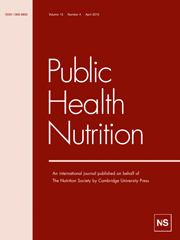Editorial
On authorship, mentorship and responsibility for data accuracy
-
- Published online by Cambridge University Press:
- 01 April 2010, pp. 451-452
-
- Article
-
- You have access
- HTML
- Export citation
Monitoring and surveillance
Research Paper
Are fish eaters healthier and do they consume less health-care resources?
-
- Published online by Cambridge University Press:
- 01 September 2009, pp. 453-460
-
- Article
-
- You have access
- HTML
- Export citation
Synergy of BMI and family history on diabetes: the Humboldt Study
-
- Published online by Cambridge University Press:
- 26 August 2009, pp. 461-465
-
- Article
-
- You have access
- HTML
- Export citation
Severe tooth loss in older adults as a key indicator of compromised dietary quality
-
- Published online by Cambridge University Press:
- 20 August 2009, pp. 466-474
-
- Article
-
- You have access
- HTML
- Export citation
Food consumption and nutritional status of people living with HIV/AIDS (PLWHA): a case of Thika and Bungoma Districts, Kenya
-
- Published online by Cambridge University Press:
- 17 September 2009, pp. 475-479
-
- Article
-
- You have access
- HTML
- Export citation
Fruit and vegetable intake in Austrian adults: intake frequency, serving sizes, reasons for and barriers to consumption, and potential for increasing consumption
-
- Published online by Cambridge University Press:
- 07 October 2009, pp. 480-487
-
- Article
-
- You have access
- HTML
- Export citation
Assessment and methodology
Research Paper
Optimal waist:height ratio cut-off point for cardiometabolic risk factors in Turkish adults
-
- Published online by Cambridge University Press:
- 28 September 2009, pp. 488-495
-
- Article
-
- You have access
- HTML
- Export citation
Biological and behavioural determinants
Research Paper
Childhood overweight and obesity among Kenyan pre-school children: association with maternal and early child nutritional factors
-
- Published online by Cambridge University Press:
- 05 November 2009, pp. 496-503
-
- Article
-
- You have access
- HTML
- Export citation
Social, economic, political and environmental determinants
Research Paper
Determinants of breast-feeding in a Finnish birth cohort
-
- Published online by Cambridge University Press:
- 13 October 2009, pp. 504-513
-
- Article
-
- You have access
- HTML
- Export citation
Barriers to increasing fruit and vegetable intakes in the older population of Northern Ireland: low levels of liking and low awareness of current recommendations
-
- Published online by Cambridge University Press:
- 22 October 2009, pp. 514-521
-
- Article
-
- You have access
- HTML
- Export citation
Roles, perceptions and control of infant feeding among low-income fathers
-
- Published online by Cambridge University Press:
- 16 November 2009, pp. 522-530
-
- Article
-
- You have access
- HTML
- Export citation
Vitamin D status and attitudes towards sun exposure in South Asian women living in Auckland, New Zealand
-
- Published online by Cambridge University Press:
- 04 August 2009, pp. 531-536
-
- Article
-
- You have access
- HTML
- Export citation
Television viewing, computer game play and book reading during meals are predictors of meal skipping in a cross-sectional sample of 12-, 14- and 16-year-olds
-
- Published online by Cambridge University Press:
- 22 September 2009, pp. 537-543
-
- Article
-
- You have access
- HTML
- Export citation
Interventions
Research Paper
Halo effect of a weight-loss trial on spouses: the DIRECT-Spouse study
-
- Published online by Cambridge University Press:
- 26 August 2009, pp. 544-549
-
- Article
-
- You have access
- HTML
- Export citation
Knowledge, attitudes and potential response to menu labelling in an urban public health clinic population
-
- Published online by Cambridge University Press:
- 26 August 2009, pp. 550-555
-
- Article
-
- You have access
- HTML
- Export citation
Effectiveness of an educational intervention on complementary feeding practices and growth in rural China: a cluster randomised controlled trial
-
- Published online by Cambridge University Press:
- 26 August 2009, pp. 556-565
-
- Article
-
- You have access
- HTML
- Export citation
Cost-effectiveness of mandatory folate fortification v. other options for the prevention of neural tube defects: results from Australia and New Zealand
-
- Published online by Cambridge University Press:
- 17 September 2009, pp. 566-578
-
- Article
-
- You have access
- HTML
- Export citation
Significant effects of implementation of health-promoting schools on schoolteachers’ nutrition knowledge and dietary intake in Taiwan
-
- Published online by Cambridge University Press:
- 06 August 2009, pp. 579-588
-
- Article
-
- You have access
- HTML
- Export citation
Public policies
Research Paper
Policies that restrict sweetened beverage availability may reduce consumption in elementary-school children
-
- Published online by Cambridge University Press:
- 28 October 2009, pp. 589-595
-
- Article
-
- You have access
- HTML
- Export citation
Erratum
Effect of dietary fatty acid intake on prospective weight change in the Heidelberg cohort of the European Prospective Investigation into Cancer and Nutrition – Erratum
-
- Published online by Cambridge University Press:
- 12 February 2010, p. 596
-
- Article
-
- You have access
- HTML
- Export citation



